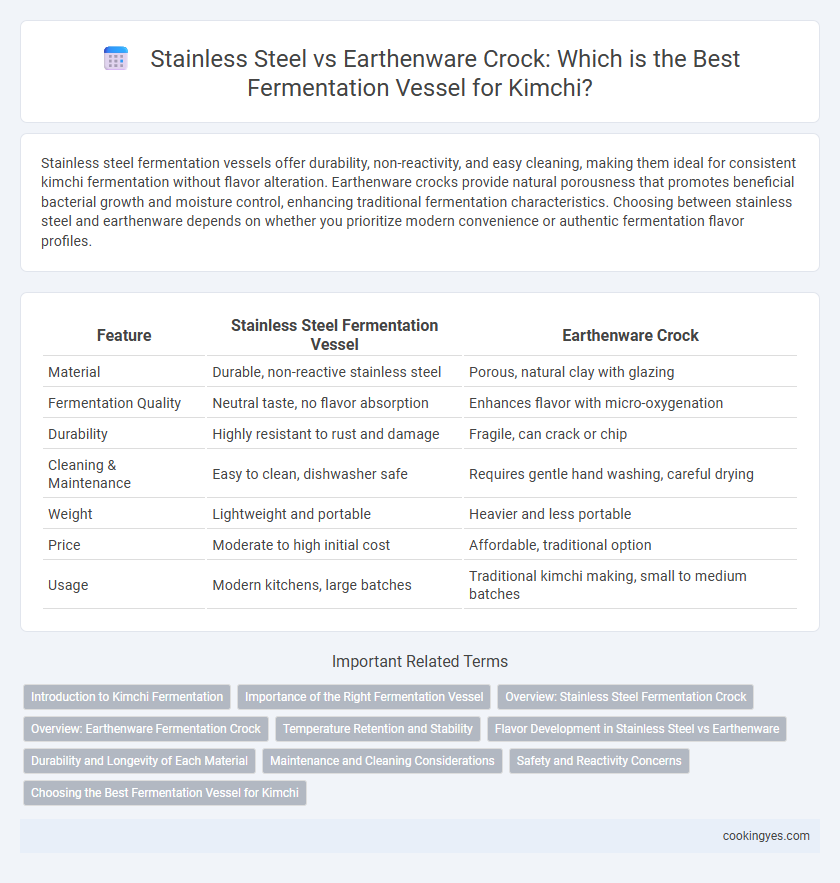Stainless steel fermentation vessels offer durability, non-reactivity, and easy cleaning, making them ideal for consistent kimchi fermentation without flavor alteration. Earthenware crocks provide natural porousness that promotes beneficial bacterial growth and moisture control, enhancing traditional fermentation characteristics. Choosing between stainless steel and earthenware depends on whether you prioritize modern convenience or authentic fermentation flavor profiles.
Table of Comparison
| Feature | Stainless Steel Fermentation Vessel | Earthenware Crock |
|---|---|---|
| Material | Durable, non-reactive stainless steel | Porous, natural clay with glazing |
| Fermentation Quality | Neutral taste, no flavor absorption | Enhances flavor with micro-oxygenation |
| Durability | Highly resistant to rust and damage | Fragile, can crack or chip |
| Cleaning & Maintenance | Easy to clean, dishwasher safe | Requires gentle hand washing, careful drying |
| Weight | Lightweight and portable | Heavier and less portable |
| Price | Moderate to high initial cost | Affordable, traditional option |
| Usage | Modern kitchens, large batches | Traditional kimchi making, small to medium batches |
Introduction to Kimchi Fermentation
Kimchi fermentation thrives in vessels that maintain stable temperature and anaerobic conditions, with stainless steel and earthenware crock as popular choices. Stainless steel offers durability, non-porous surfaces, and ease of cleaning, which prevents contamination and maintains a consistent fermentation environment. Earthenware crocks, made from porous clay, allow natural air circulation that enhances microbial activity, preserving traditional fermentation flavors essential for authentic kimchi.
Importance of the Right Fermentation Vessel
Choosing the right fermentation vessel is crucial for creating authentic kimchi, as stainless steel and earthenware crocks offer distinct benefits that influence flavor and fermentation quality. Stainless steel provides a non-reactive, easy-to-clean surface that prevents contamination and maintains consistent temperatures, while earthenware crocks promote traditional, slow fermentation through their porous structure and natural insulation. Selecting a vessel tailored to fermentation style ensures optimal lactic acid bacteria growth, resulting in the perfect balance of tangy, umami-rich kimchi.
Overview: Stainless Steel Fermentation Crock
Stainless steel fermentation crocks offer a durable, non-porous surface that resists rust and corrosion, ensuring a hygienic environment for kimchi fermentation. Their airtight seals and easy-to-clean design minimize contamination risks and help maintain consistent temperature and humidity levels critical for optimal fermentation. Unlike earthenware, stainless steel crocks do not absorb odors or flavors, preserving the authentic taste profile of kimchi.
Overview: Earthenware Fermentation Crock
Earthenware fermentation crocks provide an ideal environment for kimchi fermentation due to their porous nature, which allows for slow air exchange and maintains consistent humidity levels. These crocks help preserve the authentic flavor profile by promoting anaerobic fermentation, essential for developing the characteristic tang of traditional kimchi. Unlike stainless steel, earthenware crocks do not impart metallic flavors, ensuring a pure, natural fermentation process.
Temperature Retention and Stability
Stainless steel fermentation vessels offer superior temperature retention due to their dense material and reflective properties, maintaining a consistent environment crucial for kimchi fermentation. Earthenware crocks provide natural insulation and moderate heat exchange, promoting stable fermentation temperatures but are more susceptible to environmental fluctuations. Choosing between stainless steel and earthenware crocks depends on the desired temperature control precision and the ambient conditions during kimchi fermentation.
Flavor Development in Stainless Steel vs Earthenware
Stainless steel fermentation vessels offer a neutral environment that preserves the crisp, clean flavors of kimchi without imparting any additional taste, making them ideal for those seeking a pure, consistent flavor profile. Earthenware crocks, made from porous clay, enhance kimchi's flavor by allowing micro-oxygenation and promoting beneficial microbial activity, resulting in a more complex, tangy, and deeply fermented taste. The natural breathability of earthenware encourages diverse fermentation processes that stainless steel cannot replicate, significantly impacting kimchi's flavor development.
Durability and Longevity of Each Material
Stainless steel fermentation vessels offer exceptional durability due to their resistance to rust, corrosion, and physical damage, making them ideal for long-term use in kimchi fermentation. Earthenware crocks, while traditional and allowing for natural breathability that can enhance fermentation flavor, are more fragile and prone to cracking, which may limit their longevity. Over time, stainless steel maintains structural integrity better, whereas earthenware requires careful handling to extend its usability during the kimchi fermentation process.
Maintenance and Cleaning Considerations
Stainless steel fermentation vessels offer a hygienic, non-porous surface that simplifies cleaning and prevents flavor absorption, reducing the risk of bacterial contamination compared to earthenware crocks. Earthenware crocks require more meticulous maintenance due to their porous nature, which can harbor bacteria and yeast, necessitating thorough drying and occasional sealing to maintain sanitary conditions. Regular cleaning with non-abrasive brushes and avoiding harsh chemicals is crucial for both materials to ensure optimal fermentation results and longevity of the vessel.
Safety and Reactivity Concerns
Stainless steel fermentation vessels are non-reactive and resistant to corrosion, ensuring that kimchi ferments without metallic contamination or harmful chemical leaching. Earthenware crocks, while traditional, can absorb moisture and harbor bacteria if not properly glazed or maintained, potentially affecting fermentation safety. Choosing stainless steel minimizes risks of unwanted flavor changes and maintains a hygienic environment, whereas earthenware requires careful cleaning to prevent reactive interaction with kimchi's acidity.
Choosing the Best Fermentation Vessel for Kimchi
Stainless steel fermentation vessels offer durability, non-reactivity, and ease of cleaning, making them ideal for consistent kimchi fermentation without flavor alteration. Earthenware crocks provide natural breathability and micro-oxygenation that enhance traditional fermentation, contributing to complex flavors and authentic texture. Selecting the best vessel depends on balancing durability and flavor development, with stainless steel favored for convenience and earthenware for artisanal kimchi quality.
Stainless Steel vs Earthenware Crock for Fermentation Vessel Infographic

 cookingyes.com
cookingyes.com